Gene Pool of Winter Wheat from the World Collection of N.I. Vavilov Institute of Plant Industry (VIR) for Biotic Stress Resistance
Abstract
:1. Introduction
2. Results and Discussion
2.1. Pink Snow Mold, Pathogen Microdochium nivale ((Fr) Samuels and I.C. Hallett) (syn. Fusarium nivale (Fr.) Ces.)
2.2. Powdery Mildew, Pathogen Blumeriagraminis (DC.) Speer (syn. Erysiphegraminis DC.f.sp. tritici Em. Marshal)
2.3. Brown Rust, Pathogen Puccinia triticina Eriks
2.4. Root Rots, Fusarium Blight, Pathogen Fusarium sp., Including F.culmorum F.avenaceum F.oxysporum Schlecht. ex Fr., and helminthosporiosis or Common Root Rot, Pathogen Bipolaris sorokiniana Shoem. (syn. Drechslera sorokiniana Subram.et Jain, Helmintosporium sativum Pam.)
2.5. Resistance to Enzyme-Mycotic Depletion of Seeds
2.6. Fusarium Ear Blight, Pathogens Such as Fusarium avenaceum (Fr.) Sacc., F. culmorum (W.G. Sm.) Sacc. etc.
2.7. Septoria Leaf Blight, Pathogen Septoria tritici Rob. et Desm. and Ear Blight, Pathogen Stagonospora (syn. Septoria) Nodorum Berk
2.8. Germination in Standing Crops, Third EMDS Stage
2.9. Immunological Study of Barley Yellow Dwarfluteo Virus (Hordeum Virus Nanescens Rademacheret Schwarz) in Winter Wheat
3. Materials and Methods
4. Conclusions
Author Contributions
Funding
Institutional Review Board Statement
Informed Consent Statement
Data Availability Statement
Conflicts of Interest
References
- Vavilov, N.I. Scientific Basics of Wheat Breeding; Selkhozgiz: Leningrad, Russia, 1935; 246p. [Google Scholar]
- Vavilov, N.I. The world’s resources of drought-resistant varieties. In Proceedings of the All-Soviet Union Conference on Drought Control; Institute of Plant Industry: Leningrad, Russia, 1931; Volume 2, pp. 18–28. [Google Scholar]
- Vavilov, N.I. Selected Works in Five Volumes. Immunity Problems of Cultivated Plants; Nauka: Leningrad, Russia, 1964; Volume 4, 518p. [Google Scholar]
- Riaz, A.; Athiyannan, N.; Periyannan, S.K.; Afanasenko, O.; Mitrofanova, O.P.; Platz, G.J.; Aitken, E.A.B.; Snowdon, R.J.; Lagudah, E.S.; Hickey, L.T.; et al. Unlocking new alleles for leaf rust resistance in the Vavilov wheat collection. Theor. Appl. Genet. 2018, 131, 127–144. [Google Scholar] [CrossRef] [PubMed]
- Warburton, Y.J.; Crouch, M.J. Association mapping for enhancing maize (Zea mays L.) genetic improvement. Crop Sci. 2011, 51, 433–449. [Google Scholar]
- Beloshapkina, O.O.; Akimov, T.A. Dynamics and pathogenic composition of winter wheat root rots depending on the basic tillage methods of the sod-podzol soil. Izv. Timiryazev Agric. Acad. 2016, 3, 47–60. Available online: https://www.elibrary.ru/item.asp?id=26686928 (accessed on 5 May 2017). (In Russian).
- Kholodny, N.G. In Nature and in the Laboratory; MOIP Publ.: Moscow, Russia, 1949; Volume 1, pp. 138–145. [Google Scholar]
- Dunin, M.S.; Temirbekova, S.K. Wheat resistance to enzyme-mycotic depletion of seeds. Bull. Agric. Sci. 1978, 4, 28–39. [Google Scholar]
- Sandukhadze, B.I. The Grain: Scientists Did Their Part, Now It’s up to the Government. Available online: https://regnum.ru/news/innovatio/1993437.html (accessed on 5 May 2017). (In Russian).
- Temirbekova, S.K. Diagnostics and Evaluation of Resistance to Enzyme-Mycotic Depletion of Seeds (EMDS) in Cereal Cultivars. Methodical Guidelines; Russian Academy of Agricultural Sciences: Moscow, Russia, 1996; 116p. [Google Scholar]
- Dunin, M.S.; Temirbekova, S.K. Symptoms and Diagnostics of Enzyme-Mycotic Depletion of Seeds (EMDS). Cultivated Plants for Stable Agriculture in the 21st Century (Immunity, Breeding, and Introductions); Scientific Papers; Russian Academy of Agricultural Sciences: Moscow, Russia, 2011; Volume IV, pp. 57–71. [Google Scholar]
- Temirbekova, S.K. On the Problem of Enzyme-Mycotic Depletion of Seeds (Grain Exhaustion) in the Plant Industry, 2nd ed.; Russian Academy of Agricultural Sciences: Moscow, Russia, 2000; 306p. [Google Scholar]
- Shcherbakov, V.K. Mutations in the Evolution of Plant Breeding; Kolos: Moscow, Russia, 1982; 327p. [Google Scholar]
- Grоmоvа, В.В.О.; Temirbekova, S.K.; Вuуs, J. Еvаluаtiоn оf thе rеsistаnсе оf сегеаls аgаinst infесtiоn bу Fusarium оf thе еаrs during thе еnzуmаtiс stаdium оf еnzime-micotic seed exhaustion (EMES). In Proceedings of the Вrighton Crop Соnference: Реsts–Diseases, Brighton, UK, 18–21 November 1996; Вгitish Сгор Ргоtесtiоn Council: London, UK, 1996. [Google Scholar]
- Glinushkin, A.P.; Beloshapkina, O.O.; Akimov, T.A. Composition of pathogenic mycobiota of seed material of wheat. In Proceedings of the III International Mycological Forum—“Current Mycology in Russia”, Moscow, Russia, 14–15 April 2015; National Academy of Mycology: Moscow, Russia, 2005; Volume 5, pp. 46–47. [Google Scholar]
- Temirbekova, S.K.; Cheremisova, T.D.; Mitrofanova, O.P.; Maksimova, A.V. Genetic Resources of Soft Winter Wheat for Breeding Purposes; All-Russian Horticultural Institute for Breeding, Agrotechnology, and Nursery: Moscow, Russia, 2008; 507p. [Google Scholar]
- Fedorin, Y.V.; Sotnikov, V.P.; Egorenkov, L.I. Soils of the USSR’s Agricultural Lands: Scientific Edition; Kolos: Moscow, Russia, 1981; 199p. [Google Scholar]
- Gradchaninova, O.D.; Filatenko, A.A.; Rudenko, M.I. Methodical Guidelines for Studying the World Collection of Wheat; VIR Publ.: Leningrad, Russia, 1987; p. 28. [Google Scholar]
- Merezhko, A.F.; Udachin, R.A.; Zuev, E.V.; Filotenko, A.A.; Serbin, A.A.; Liapunova, O.A.; Kosov, V.I.; Kurkiev, U.K.; Okhotnikova, T.V.; Nazrubekov, N.A.; et al. Replenishment, Preservation in a Viable State, and Studying of a World Collection of Wheat, Goatgrass, and Triticale. Methodical Guidelines; VIR Publ.: St. Petersburg, Russia, 1999; 81p. [Google Scholar]
- Genaev, M.; Komyshev, E.; Smirnov, N.; Kruchinina, Y.; Goncharov, N.P.; Afonnikov, D. International Comecon List of Descriptors for the Genus Triticum, L.; VIR: Leningrad, Russia, 1989; 43p. [Google Scholar]
- Zakharenko, V.A.; Medvedev, A.M.; Erokhina, S.A.; Kovalenko, E.D.; Dobrovolskaya, G.V.; Mikhailov, A.A. Methodology for Assessing the Resistance of Field Crop Varieties to Diseases on Infectious and Provocative Backgrounds; Russian Agricultural Academy: Moscow, Russia, 2000; 88p. [Google Scholar]
- Study of the Genetic Resources of Grain Crops for Resistance to Harmful Organisms. Methodological Guide; Radchenko, E.E. (Ed.) Russian Agricultural Academy: Moscow, Russia, 2008; 416p. [Google Scholar]
- James, W.C. An illustrated series of assessment keys for plant diseases their preparation and usage. Canad. Plant Dis. Surv. 1971, 51, 38–65. [Google Scholar]
- Bilai, V.I. Fusarium species on grain of grain cereals and their toxicological properties. Microbiology 1974, 16, 11–17. [Google Scholar]
- Grigoriev, M.F. Methodological Guidelines for the Study of Resistance of Grain Crops to Root Rot; VIR: Leningrad, Russia, 1976; 67p. [Google Scholar]
- Vlasov, Y.I.; Teploukhova, T.N.; Larina, E.I. Detection, Identification and Basics of the Epiphytotyology of BYDV (Yellow Dwarfism Virus of Barley); Vaskhnil: Moscow, Russia, 1990; 19p. [Google Scholar]
- Temirbekova, S.K.; Popova, E.V.; Tyuterev, S.L.; Alimov, K.G.; Gromova, B.B.O. About some results of studies of enzymo-mycose seed depletion (EMIS). In The Collection: Cultivated Plants for Sustainable Agriculture in the XXI Century (Immunity, Selection, Introduction). Scientific Works; Russian Agricultural Academy: Moscow, Russia, 2002; pp. 117–135. [Google Scholar]
- Temirbekova, S.K.; Popova, E.V.; Buys, J.; van Mansvelt, J.D. On the search of disease resistant biotypes within the population of Russian and Dutch reproductions of European winterwheat varieties. In European Journal of Plant Pathology, ХIII Intеrnаtiоnal Рlant Ргоtесtiоn Соngress: The Hague, Тhе Nеtherlands, 2–7 July 1995; Springer: The Hague, Тhе Nеtherlands, 1995; p. 1055. [Google Scholar]
- Voronkova, A.A. Genetic and Immunological Basis of Wheat Breeding for Rust Resistance; Kolos: Moscow, Russia, 1980; 191p. [Google Scholar]
- Molchan, I.M. Genetic peculiarities of a plasticity variety and principles of adaptive breeding. Plant Breed. Seed Prod. 1993, 3, 10–15. [Google Scholar]
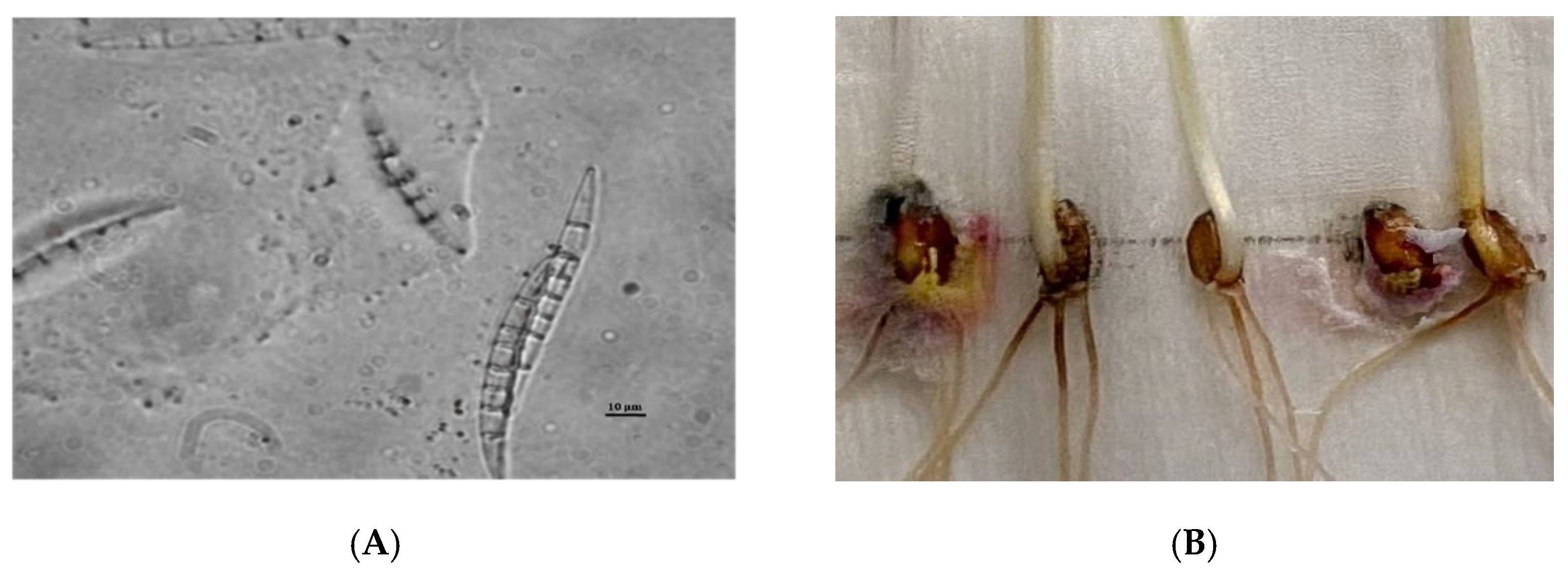
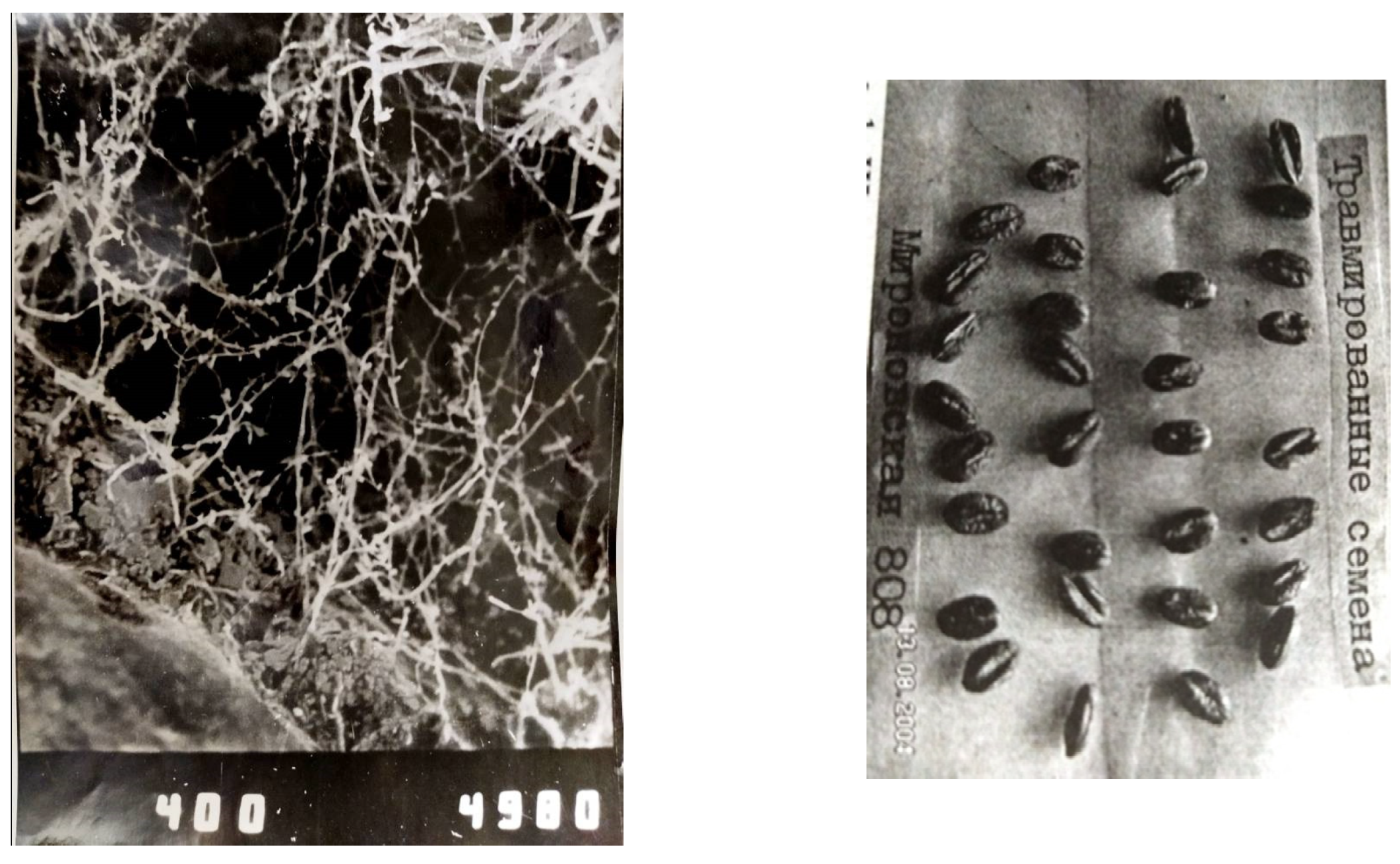
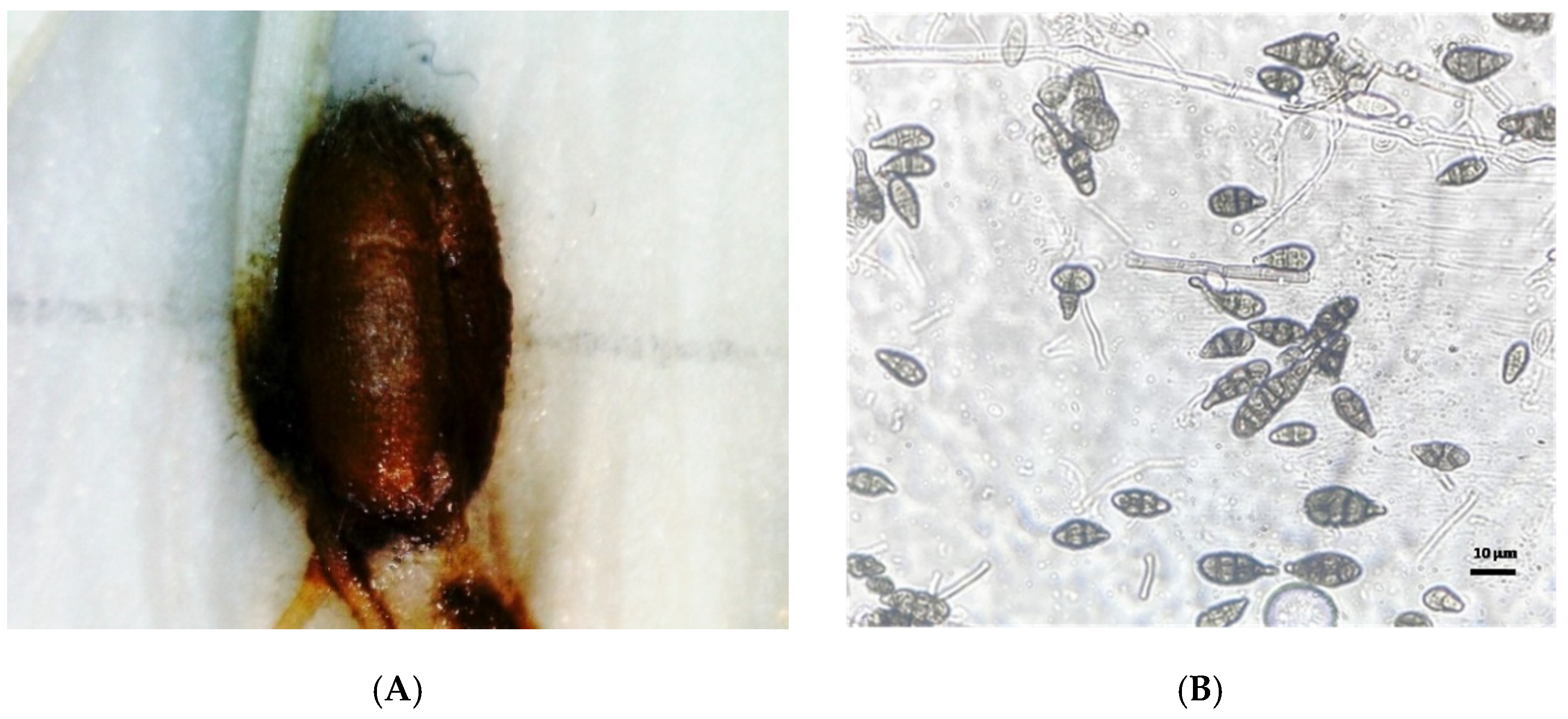

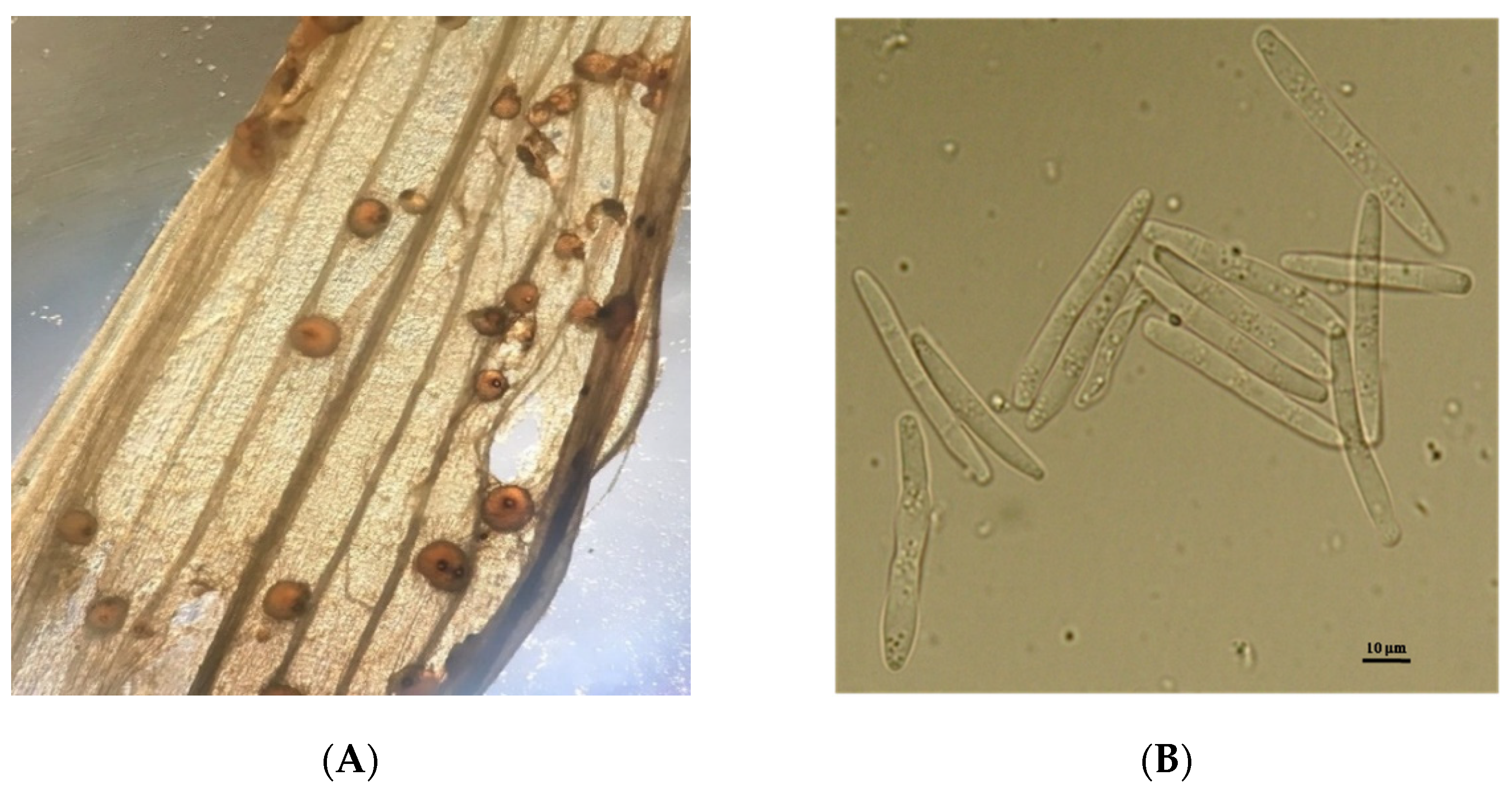
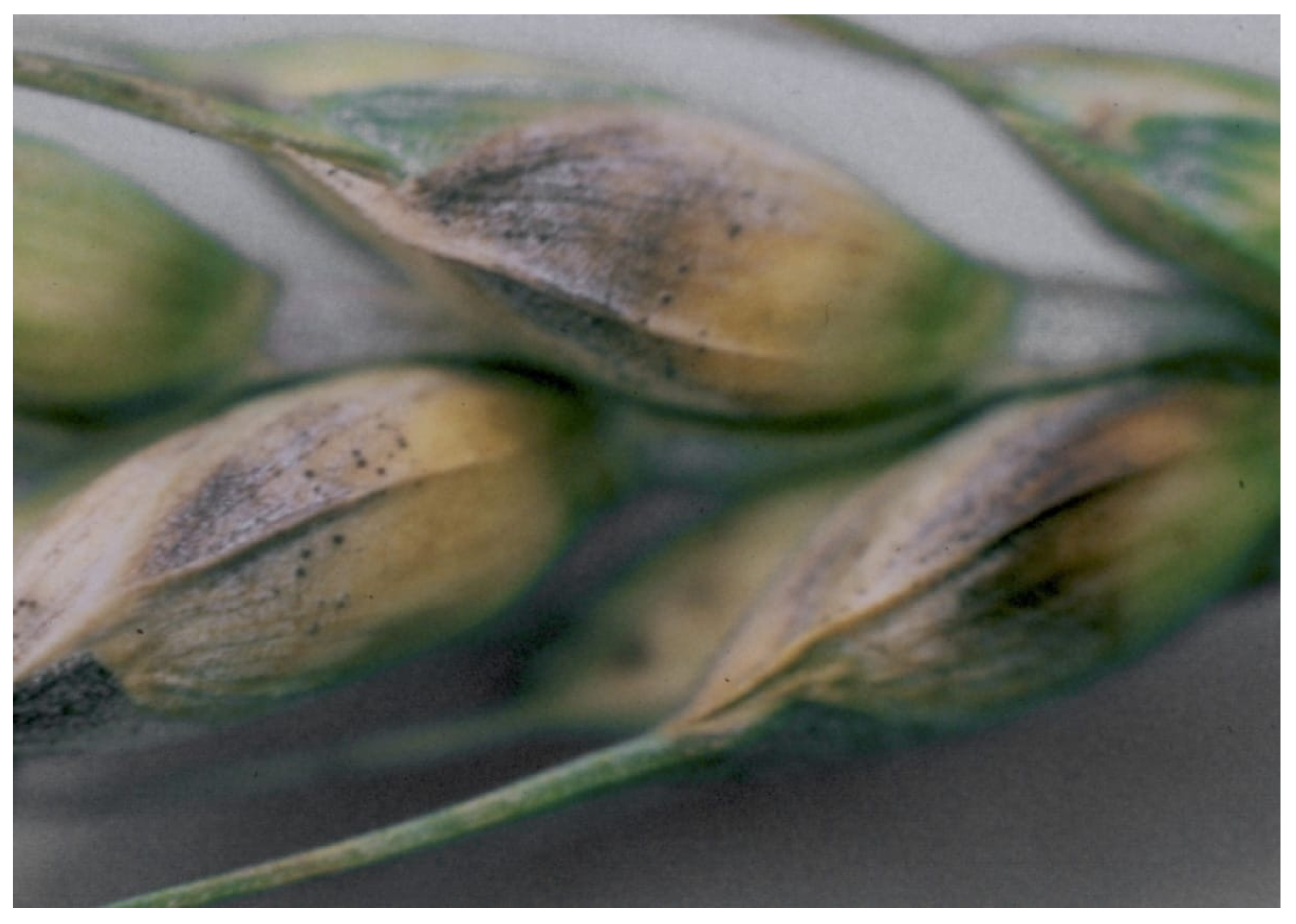
| VIR Catalogue No. | Variety | Origin | Germinating Energy | Germinating Power |
Infected Seeds,% (A. Alternata) | Crop Yield, g/m2 |
|---|---|---|---|---|---|---|
| 54668 | Lutescens 444/73 | Russia, Moscow Region. | 24.00 | 35.00 | 5.00 | 570 |
| 54706 | Monopol | Germany | 59.00 | 80.00 | 11.00 | 510 |
| 55529 | Tundra | the Netherlands | 48.00 | 69.00 | 12.00 | 515 |
| 55801 | Lutescens 12 | Russia, the Kursk Region | 44.00 | 78.00 | 9.00 | 600 |
| 55930 | TAW 3295/73 | Germany pre-1949 | 70.00 | 95.00 | 0.00 | 4225 |
| 55932 | TAW 12181/72 | Germany pre-1949 | 44.00 | 65.00 | 0.00 | 390 |
| 55933 | TAW 13802/72 | Germany pre-1949 | 31.00 | 52.00 | 0.00 | 510 |
| 55944 | TAW 4229/74 | Germany pre-1949 | 20.00 | 42.00 | 0.00 | 525 |
| 55971 | L-1749 | Russia, the Kursk Region | 36.00 | 36.00 | 0.00 | 620 |
| 56339 | Derwent | England | 32.00 | 49.00 | 0.00 | 530 |
| 57221 | Oberst | Germany | 20.00 | 41.00 | 0.00 | 475 |
| 57222 | Severin | Germany | 45.00 | 60.00 | 0.00 | 620 |
| 57614 | Kadav | Poland | 42.00 | 65.00 | 0.00 | 540 |
| 58036 | Folke | Sweden | 72.00 | 84.00 | 0.00 | 505 |
| 58138 | Ragnar | Sweden | 40.00 | 64.00 | 15.00 | 420 |
| 58302 | Falke | Germany | 60.00 | 69.00 | 0.00 | 395 |
| 58305 | Faras | Germany pre-1949 | 32.00 | 45.00 | 0.00 | 450 |
| 58367 | SMH 1624 | Poland | 29.00 | 41.00 | 0.00 | 460 |
| 58831 | Lutescens 398 | Russia, Voronezh region | 21.00 | 37.00 | 18.00 | 585 |
| 62274 | Hankkijas Ilves | Finland | 35.00 | 48.00 | 0.00 | 350 |
| 57009 | Disponent | Germany | 37.00 | 64.00 | 0.00 | 370 |
| VIR Catalogue No. | Variety | Origin | Crop Yield, g/m2 | 1000-Grain Weight, g | Germinating Power | Germinating Energy | Infected Seeds % | |
|---|---|---|---|---|---|---|---|---|
| A. Alternata | Fusarium sp. | |||||||
| 5144 | Kubb | Sweden | 395 | 44 | 75.00 | 80.00 | 10.00 | |
| 9087 | Banatka | Russia, Voronezh Region | 535 | 24 | 8.00 | 8.00 | 97.00 | |
| 9681 | - | Russia, Kaluga Region | 467.5 | 29 | 1.00 | 4.00 | 92.00 | |
| 9695 | - | Russia, Vladimir Region | 322.5 | 40 | 39.00 | 45.00 | 88.00 | |
| 9696 | - | Russia, Vladimir Region | 465 | 27 | 48.00 | 52.00 | 40.00 | |
| 9762 | - | Russia, Tver Region | 360 | 33 | 12.00 | 12.00 | 24.00 | |
| 9765 | Mestnaya | Russia, Pskov Region | 512.5 | 30 | 4.00 | 12.00 | 99.00 | |
| 10010 | Kraffts Verbesserter Siegerlaender | Germany pre-1949 | 382.5 | 33 | 0.00 | 0.00 | 95.00 | |
| 5183 | Smoa | Sweden | 347.5 | 37 | 20.00 | 32.00 | 37.00 | |
| 6258 | Beal | Germany pre-1949 | 365 | 44 | 52.00 | 64.00 | 55.00 | 5.00 |
| 10267 | - | Russia, Smolensk Region | 297.5 | 38 | 8.00 | 12.00 | 85.00 | 9.00 |
| 10473 | Tomskaya | Russia, the Tomsk Region | 305 | 23 | 28.00 | 32.00 | 19.00 | |
| 10566 | - | Russia, the Pskov Region | 477.5 | 43 | 20.00 | 20.00 | 32.00 | |
| 10571 | - | Russia, Leningrad Region | 270 | 35 | 12.00 | 16.00 | 36.00 | |
| 6301 | Roggen | Germany pre-1949 | 282.5 | 39 | 36.00 | 40.00 | 34.00 | |
| 6302 | Roberts | Germany pre-1949 | 335 | 32 | 23.00 | 36.00 | 37.00 | |
| 13221 | - | Russia, Tver Region | 457.2 | 29 | 16.00 | 28.00 | 25.00 | |
| 13121 | Tystofte Smaahvede II | Denmark | 365 | 34 | 28.00 | 44.00 | 60.00 | |
| 15199 | Moskovskaya 2470 | Russia, Moscow Region | 295 | 39 | 30.00 | 36.00 | 32.00 | |
| 19106 | Kostromka | Russia, Tver Region | 442.5 | 40 | 55.00 | 60.00 | 37.00 | |
| 22428 | - | Russia, Tver Region | 557.5 | 39 | 48.00 | 52.00 | 10.00 | 5.00 |
| 15197 | Moskovskaya 2453 | Russia, Moscow Region | 390 | 37 | 3.00 | 8.00 | 57.00 | |
| 15198 | Moskovskaya 2460 | Russia, Moscow Region | 317.5 | 35 | 4.00 | 6.00 | 49.00 | 3.00 |
| 19099 | - | Russia, Tver Region | 545 | 41 | 43.00 | 61.00 | 31.00 | |
| 19399 | - | Russia, Krasnoyarsk Krai | 385 | 32 | 0.00 | 4.00 | 99.00 | |
| 22391 | Moskovskaya 2323 | Russia, Moscow Region | 357.5 | 42 | 6.00 | 17.00 | 36.00 | |
| 22418 | Sandomirka | Russia, Orel Region | 447.5 | 38 | 42.00 | 65.00 | 11.00 | |
| 25143 | Ankar | Sweden | 375 | 41 | 50.00 | 67.00 | 36.00 | |
| 25147 | Kroontarwe | the Netherlands | 382.5 | 47 | 0.00 | 0.00 | 95.00 | |
| 25153 | W x EP | the Netherlands | 590 | 44 | 35.00 | 40.00 | 22.00 | |
| 26140 | Siegerlander | Germany pre-1949 | 357.5 | 42 | 25.00 | 38.00 | 15.00 | |
| 24500 | Mikhailovka | Russia, Leningrad Region | 402.5 | 37 | 2.00 | 5.00 | 42.00 | |
| 24923 | - | Russia, Primorsky Krai | 305 | 38 | 10.00 | 16.00 | 10.00 | |
| 50610 | Hadmerslebener 25603/70 | GDR pre-1990 | 532.5 | 40 | 81.00 | 84.00 | 4.00 | |
| 50672 | Hadmerslebener 42498/71 | GDR pre-1990 | 675 | 46 | 56.00 | 68.00 | 33.00 | |
| 19108 | - | Russia, Tver Region | 375 | 39 | 20.00 | 28.00 | 35.00 | |
| 51423 | 977 | Russia, Tambov Region | 585 | 49 | 8.00 | 24.00 | 61.00 | |
| 59546 | General | Germany | 535 | 50 | 20.00 | 44.00 | 29.00 | |
| 60304 | TAW 8913/74 | Germany pre-1990 | 770 | 50 | 24.00 | 40.00 | 52.00 | |
| 26228 | Bensings Trotzkopf | Germany pre-1949 | 407.5 | 46 | 80.00 | 87.00 | 8.00 | |
Publisher’s Note: MDPI stays neutral with regard to jurisdictional claims in published maps and institutional affiliations. |
© 2021 by the authors. Licensee MDPI, Basel, Switzerland. This article is an open access article distributed under the terms and conditions of the Creative Commons Attribution (CC BY) license (https://creativecommons.org/licenses/by/4.0/).
Share and Cite
Temirbekova, S.; Jafarov, I.; Kulikov, I.; Afanaseva, Y.; Kalashnikova, E. Gene Pool of Winter Wheat from the World Collection of N.I. Vavilov Institute of Plant Industry (VIR) for Biotic Stress Resistance. Pathogens 2021, 10, 514. https://doi.org/10.3390/pathogens10050514
Temirbekova S, Jafarov I, Kulikov I, Afanaseva Y, Kalashnikova E. Gene Pool of Winter Wheat from the World Collection of N.I. Vavilov Institute of Plant Industry (VIR) for Biotic Stress Resistance. Pathogens. 2021; 10(5):514. https://doi.org/10.3390/pathogens10050514
Chicago/Turabian StyleTemirbekova, Sulukhan, Ibrahim Jafarov, Ivan Kulikov, Yuliya Afanaseva, and Elena Kalashnikova. 2021. "Gene Pool of Winter Wheat from the World Collection of N.I. Vavilov Institute of Plant Industry (VIR) for Biotic Stress Resistance" Pathogens 10, no. 5: 514. https://doi.org/10.3390/pathogens10050514








